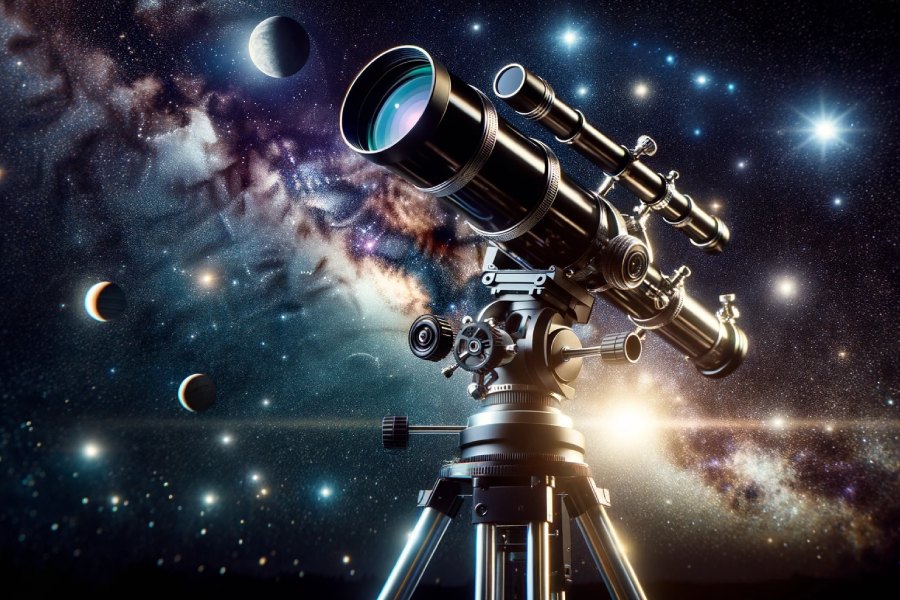Gazing at cosmic wonders – from lunar craters to Saturn’s rings to galaxies light years beyond – telescopes seem like magical devices unveiling the cosmos’s endless marvels. But what determines the telescope specifications that differentiate a telescope from a telescope? How much detail, color, and faint celestial objects do different telescopes reveal?
We will compare technical factors like included software, available filters, resolution limits, and manufacturer quality control. With informed insight into these critical telescope criteria, readers can discover how to select the ideal scope that aligns with their interests and vision of the cosmos.

Telescope Specifications
Telescope specifications refer to the detailed characteristics and features of a telescope that define its performance and capabilities. Telescopes are defined by specifications such as aperture, focal length, focal ratio, type of optics, and mounting type.
Additionally, telescope specifications may detail the type of eyepieces and accessories it supports. Specifications may include any specialized features like GoTo technology for automated celestial object tracking.
Understanding these specifications is crucial for astronomers and enthusiasts when selecting a telescope. This understanding ensures the telescope is suited to their observation goals, whether it be for stargazing, astrophotography, or specific astronomical research.
Basic Telescope Specifications
Key specifications like aperture, focal length, focal ratio, optics type, and mount distinguish telescope capabilities. These parameters guide selection fitting observation goals from low to high magnification uses.
Aperture and focal length
Aperture indicates light gathering area set by the diameter of the primary mirror or lens. The aperture determines the brightness of the lens, the number of objects visible, and the limiting resolution. As a rule of thumb, the larger the aperture, the fainter the objects.
Focal length, on the other hand, controls magnification based on attached eyepieces. Focal length is actually the distance from the objective of the telescope to the focal point. Longer focal lengths result in narrower fields of view with higher magnification potential.
Focal ratio and optics type
The focal ratio compares the focal length to aperture defining image brightness. Slower ratios yield brighter images. Refractor telescopes use glass lenses, while reflectors use mirrors. Reflectors can achieve greater light-gathering ability at lower cost.
Mounting type and additional features
Equatorial mounts track objects by single-axis rotation, while altazimuth mounts move altitude and azimuth directionally requiring dual tracking. Features like motorization, GPS, and GoTo automation enable automatically locating thousands of celestial objects.
Types of Telescopes
Telescopes are broadly classified into refractive, reflective, and compound categories based on fundamental optics. Refractors focus light through objective lenses, while reflectors leverage curved mirrors. Compound telescopes combine both lens and mirror elements synergistically.
Refractor telescopes
Refractors utilize glass or crystal objective lenses to collect, focus, and magnify light. Well-suited for observing planets and the moon, quality crown and flint glass lenses ensure good aberration correction.
These lenses provide wide, bright fields ideal for terrestrial needs, too. Refractors boast elegant tube forms lighter than bulkier reflector counterparts.
Reflector telescopes
Reflectors gather more light with larger primary mirrors versus refractor lenses for detailed cosmic vistas. Parabolic mirrors reduce optical distortions with a central blocked secondary mirror directing light to the eyepiece side for observation.
Reflectors excel in serving astrophotography, faint deep space viewing, and research via customizable precision optics at a relatively affordable scale.
Compound telescopes
Compound telescopes integrate mirror and lens elements, combining advantages in innovative optical tube arrangements, improving image quality and illumination across wide spectra.
For example, Schmidt-Cassegrain variants join corrector plates to curved primary mirrors. This orthogonally redirects light to side-mounted eyepieces, avoiding secondary mirror blockage with versatile results.

Mounts for Telescopes
Mounts provide foundational telescope structure, enabling smooth orientation along axes and facilitating celestial tracking at varying magnifications. Key types include Alt-Azimuth (Alt-Az) and Equatorial mounts using unique rotational approaches.
Alt-Az mounts
Alt-Az mounts utilize horizontal azimuth axes for panning paired with vertical altitude axes controlling up-down pointing enabling flexible view repositioning.
Dual axis movement requires tracking motors separately, driving both synchronized azimuth and altitude angles when following cosmic objects’ long exposures. Alt-Az mounts offer simplicity for beginners with intuitive pan-tilt motions.
Equatorial mounts
Equatorial mounts feature a polar axis for declination angle adjustment while the dec locking mechanism enables precision right ascension rotational tracking akin to Earth’s axis orientation.
This allows smooth one-axis guidance via the sidereal rate canceling field rotation when paired with a precision drive motor system for long exposure deep space astrophotography needs.
The equatorial mount’s polar axis parallels Earth’s tilted axis while stabilizing weights balance rotational torque as motors drive systematic motion canceling field rotation rates allowing long exposure astrophotography absent blurred star trailing effects by keeping pace with the skies.
Alt-Az mount
Alt-azimuth (Alt-Az) mounts provide simple vertical and horizontal rotational axes for orienting optical tubes using altitude and azimuth adjustments, enabling flexible targeting across sky views.
Azimuth axis
The azimuth axis facilitates smooth horizontal panning control of attached telescope tubes. This allows left-right targeting by rotating around the vertical altitude pillar, realigning side-to-side vantage points.
This is initially useful for locating celestial objects within the panoramic dome before fine tuning vertical elevation positioning and tracking motor engagement at higher magnifications.
Altitude axis
The altitude axis handles up and down pointing control using the vertical pivot orientation. Adjustable mounts angle tubes higher or lower while locking temporarily holds positions before motorized compensation.
Fine altitude tuning centers objects in the field of view before azimuth tracking motors maintain horizontal alignment, compensating for Earth’s rotation over long exposures. This allows to capture galaxies and nebulae in detail.
Diffraction Spikes & Corrector Plate
All telescopes exhibit certain optical effects that influence the resulting imagery in ways intrinsic to their design. Understanding these effects is worthwhile when evaluating specifications, as it can guide appropriate selection fitting imaging needs and help set realistic expectations.
Rainbow diffraction spikes
Point light sources like stars manifest eye-catching rainbow diffraction spikes stemming from the support struts that secondary mirrors employ to redirect light paths to eyepieces. These colorful “starburst” patterns showcase the intricate diffraction happening within the optical system.
The spikes serve as visible proof of central obstruction and light blockage intrinsic to reflector telescope designs, which is absent in quality refractors.
While attractive, the spikes may interfere with astrophotography involving point sources or obscure finer details around objects. Those preferring spike-free images may opt for refractors or catadioptric designs over reflectors.
Still, the spikes endure as characteristic signatures of large reflectors like Newtonians and Dobsonians, almost akin to a visual badge of honor.
Corrector plates
Certain compound telescopes utilize corrector plates with specialized optical coatings to correct for spherical aberration and field curvature issues through careful light path redirection. These correctors improve image acuity especially around the edges of the viewing field.
The corrector plate effectively counteracts optical distortion effects that could otherwise impact sharpness and planar focus uniformity across a large imaging sensor. Specifically, Schmidt-Cassegrain telescopic designs incorporate corrector plates as key elements partnered with the combined primary and secondary mirror set.
The corrector not only helps sharpen views but also allows optical tubes to be compactly sized for portability with versatile results suitable for astrophotography and amateur observation alike.
Conclusion
As we wrap up demystifying key telescope specifications to evaluate when selecting optics, we hope readers feel empowered with fresh insight about all the different specifications o by a telescope.
By illuminating the significance surrounding technical criteria from aperture and focal length to specialized features like software suites or filter kits, we aimed to peel back the layers within product feature lists.
Similar to how intricate engineering forms the foundation of today’s sophisticated telescopes to unveil the cosmos’s splendors, reading this now instills an appreciation for the blend of essential telescope specifications and components that empower those revelations.
May this knowledge not only shed light on telescope capabilities but also inspire the pursuing of ever-deeper galactic frontiers together!
